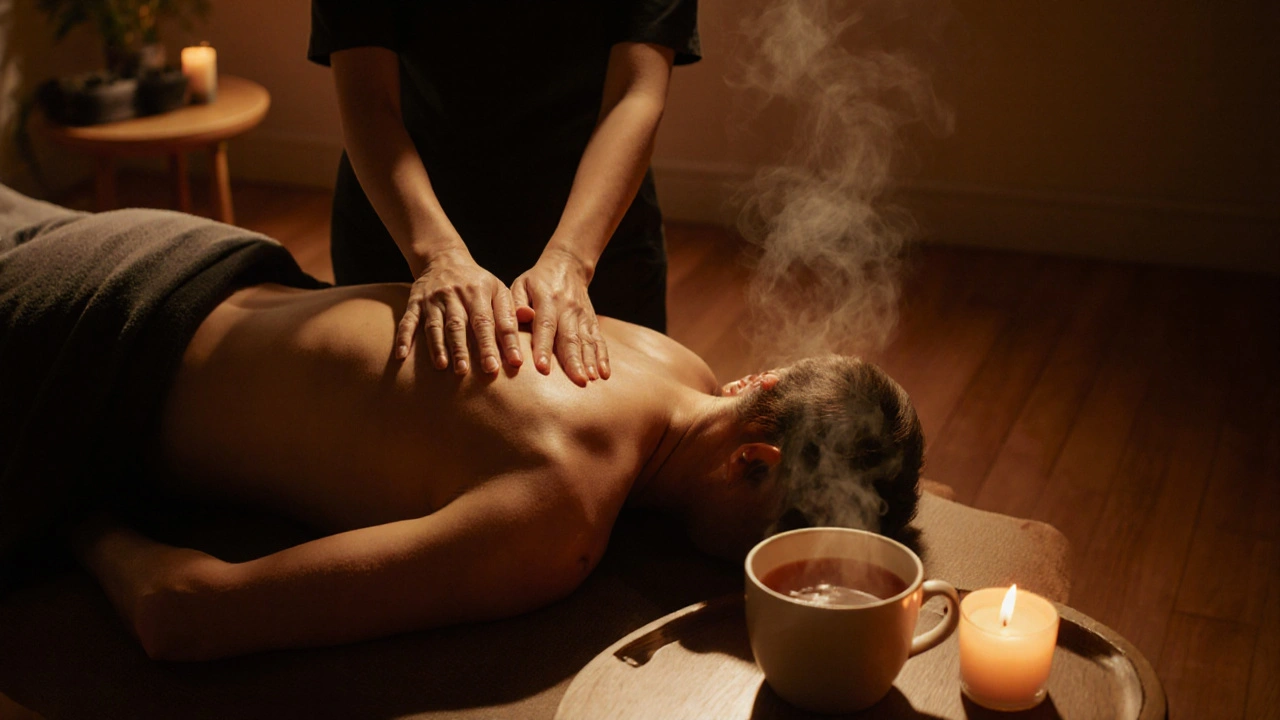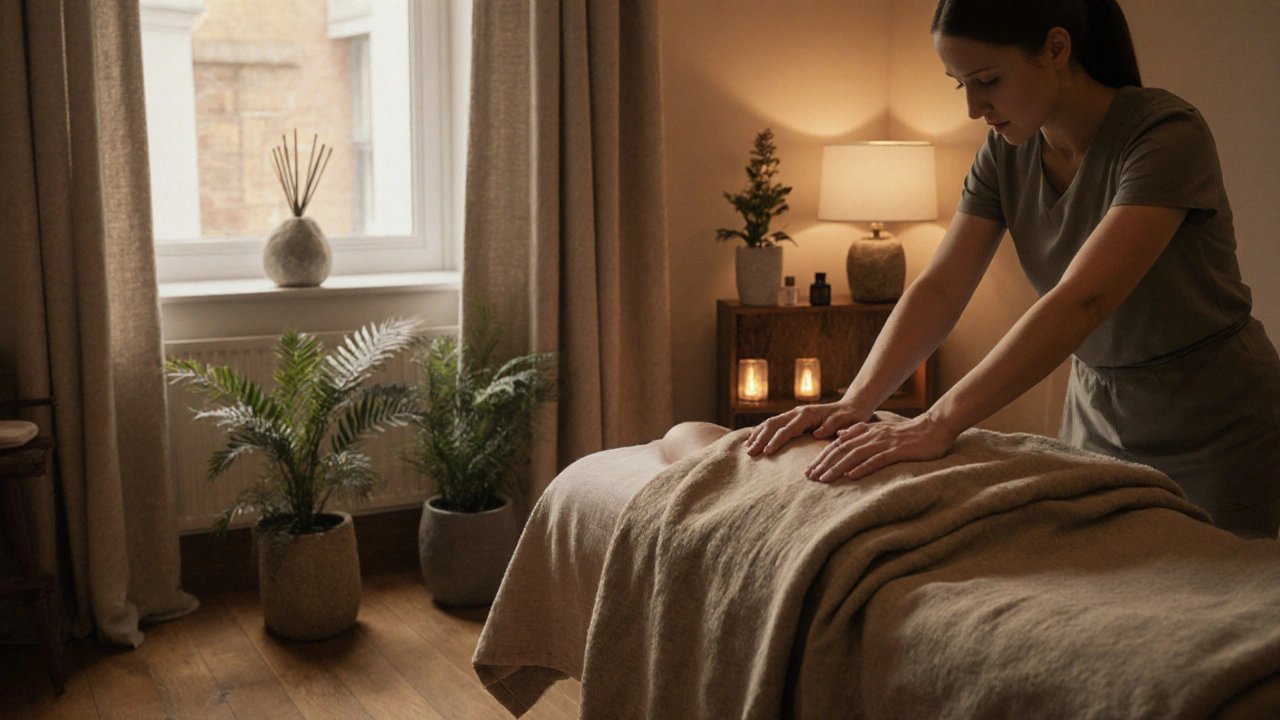Discover the best massage in London for real stress relief-not just relaxation. Learn which techniques work, where to find top therapists, what to expect, and how to book without the hassle.

- Created by: Elara Wainwright
- Completed on: 20 May 2025
- Categories: Massage London
If the never-ending buzz of London has left your shoulders up by your ears, you’re definitely not alone. Between endless meetings, Tube commutes that feel like a full-contact sport, and the general roar of the Big Smoke, most of us carry more tension than we realize. Good news? A solid massage in London isn’t just a luxury—it’s pretty much a mental reset button.
But with so many choices, it’s easy to get lost—Swedish, Thai, deep tissue, or even hot stones? Some places take walk-ins, others have waiting lists as long as your last shopping receipt. How do you cut through the fluff (and the fancy spa jargon) to actually get what your body needs?
This guide strips things back and keeps it real. You’ll find out what makes a massage truly great in London, what types are worth your time and cash, plus tips for actually booking a session you’ll love. Let’s take the stress out of finding real relaxation—no weird robes, no guesswork, just what works for real people in the city.
- Key Points at a Glance
- Direct Answer: Where to Find the Best Massage in London
- What Makes a Good Massage in London?
- Types of Massages Popular in the City
- How to Choose and Book Your Perfect Massage
- Safety Tips & What to Expect During a Session
Key Points at a Glance
London is packed with massage options, but a few key things will help you avoid disappointment and wasted money. Here are the top facts you need before booking your next treatment in this city of a thousand spas.
- Best massage London isn’t about the fanciest spa—it’s about finding the right style and therapist for your needs (stress relief, sports therapy, or just serious chill).
- The most popular types in London are Swedish, deep tissue, Thai, aromatherapy, and sports massage. Each one targets different needs. Deep tissue, for example, is top-rated for gym-goers and office workers dealing with knots.
- Prices start around £40 for 30 minutes and go up to over £120 for 90 minutes at central London locations, with luxury spas often charging more. Local independent studios in places like Hackney, Clapham, or Camden can be more affordable than swanky Mayfair spots.
- Online booking is the norm—apps like Treatwell, Urban, and Fresha let you choose your therapist, location, and even last-minute appointments. You can see real reviews there too.
- Top-rated clinics and spas follow strict hygiene and safety rules, which became even tighter since early 2020. All legitimate therapists should be trained and insured—don't settle for less.
Want a quick look at what’s out there? Check out this cost and service breakdown for a typical London massage visit:
| Type | Average Duration | Central Price | Neighborhood Price | Best For |
|---|---|---|---|---|
| Swedish | 60 mins | £80 | £50 | Full body relaxation |
| Deep Tissue | 60 mins | £90 | £60 | Muscle tension, knots |
| Thai | 60 mins | £85 | £55 | Flexibility, energy boost |
| Sports | 60 mins | £100 | £70 | Active lifestyle, injury recovery |
| Aromatherapy | 60 mins | £95 | £60 | Stress, mood improvement |
If you’re short on time, you can also get express massages at some chain spas or even airports, perfect for squeezing in a bit of relaxation between meetings or travels.
Direct Answer: Where to Find the Best Massage in London
If you’re on the hunt for the best massage London has to offer, here’s the quick answer: focus on areas known for top-rated wellness spots, check reviews, and don’t be afraid to ask locals for recommendations. Central London (like Soho, Covent Garden, and Marylebone) is packed with reputable spas and boutique studios—think The Massage Company, The Spa at Mandarin Oriental, or Champneys. South Kensington’s Bamford Wellness Spa and Shoreditch’s AIRE Ancient Baths are also worth checking out if you want something a bit different, like baths and unique rituals on top of a great massage.
Here’s a shortlist of places consistently getting five stars, both from Londoners and visitors:
- The Massage Company (Putney or High Wycombe): Super consistent, straightforward pricing, and great for first-timers or gift vouchers.
- The Spa at Mandarin Oriental (Knightsbridge): You’ll pay more, but it’s a luxury experience—perfect for celebrations or a serious treat.
- Thai Square Spa (Covent Garden): For authentic Thai and a genuine dose of calm right in the city center.
- Bamford Wellness Spa (South Kensington): Focused on organic treatments and holistic vibes. Great if you like your massage with a side of green juices.
- AIRE Ancient Baths (Shoreditch): Not just a massage, but a whole experience—thermal pools and candlelight. Book in advance here.
If you’re outside the very center, neighborhood favorites are often less crowded. Streatham’s Urban Retreat, Dalston’s Masaj, and Notting Hill’s Cloud Twelve are all solid, especially if you want something less formal and more local.
To save time, try booking platforms like Treatwell or Urban. They let you search by area, read real reviews, and book instantly—so you don’t waste your Saturday scrolling dozens of websites. Many therapists also do home visits for a little extra, if you’d rather not leave your flat.
The best spot for you depends on your needs—quick fix after work, serious deep tissue, or a slow weekend unwind with extras like aromatherapy. Read reviews, double-check credentials, and if in doubt, ask for recommendations in your neighbourhood WhatsApp group or even at your gym. Londoners love to talk about their favourite massage spots—don’t be shy to ask.
What Makes a Good Massage in London?
Not all massages are created equal. Some leave you floating out the door, others just leave your wallet lighter. In London, where time and money matter, finding a good massage means more than just picking the closest spa or the fanciest website.
A good massage experience in London usually comes down to a few things:
- Qualified Therapists: Look for places where therapists are certified (like ITEC or VTCT) and know their anatomy, not just how to rub lotion. In London, most reputable spots will list qualifications, so don’t be shy about asking.
- Cleanliness and Hygiene: A good massage centre is spotless. Fresh towels, hand sanitizer, clean oil bottles—these are basics. Any place that feels off probably is.
- Tailored Treatment: Everyone’s muscles are different. Good therapists ask about your needs—aches, injuries, crazy work stress—before you even hit the table. Don’t settle for a one-size-fits-all routine.
- Right Atmosphere: Lighting, noise level, and even room temperature can make or break your experience. No one relaxes when there’s street noise or flickering lights.
- Transparent Pricing: Upfront, clear costs are a must. Watch out for hidden charges or “extras” tacked on mid-session.
In London, the average customer rating for top massage shops sits around 4.6 stars on platforms like Google and Treatwell. If you see a pattern of low ratings or inconsistent reviews, that’s usually a red flag.
| What to Check | Why It Matters |
|---|---|
| Therapist Qualifications | Ensures the person knows their stuff—no guesswork on your body. |
| Cleanliness | Health and comfort (especially post-pandemic—it really matters). |
| Tailored Consultation | So the massage hits the right spots—not just a basic rubdown. |
| Atmosphere | You’ll actually relax—less outside noise, proper music, good vibes. |
| Reviews | Real experiences from real clients—helps set your expectations. |
| Clear Pricing | No surprise charges that kill your chill. |
One more tip: in central London, many places now offer online booking and instant confirmation, which (honestly) beats playing phone tag. And if you’re after the best massage London can offer, don’t be afraid to ask lots of questions before you book—most good therapists expect it!

Types of Massages Popular in the City
London’s massage scene is seriously diverse. Whether you need to chill after a hectic week or fix that stubborn knot in your back, the city has you covered. Here are the main types you’ll see on menus across London, explained simply—so you don’t need a degree in spa science to pick what works for you.
- Swedish Massage: This is the classic choice, perfect for beginners or anyone wanting pure relaxation. Therapists use long, gliding strokes, kneading, and gentle tapping. It’s the go-to for easing stress and light muscle aches.
- Deep Tissue Massage: Got sticky shoulders or a stiff neck from sitting at your desk? Deep tissue targets knots and tight spots with slow, firm pressure. It’s not always comfy, but seriously good if you carry tension in your body.
- Thai Massage: You don’t just lie there—this one involves stretching and yoga-like movements. Therapists might use their hands, knees, or even feet. Expect to feel looser and more flexible after, especially if you’re tight everywhere.
- Sports Massage: Don’t let the name fool you! This isn’t just for marathon runners. Sports massage focuses on problem areas and improves movement. Great if you’re dealing with chronic pain or old injuries.
- Hot Stone Massage: Warm, smooth stones are placed on your body and used to massage muscles. The heat relaxes your body faster and helps with deep tension. If you’re always cold or just want a cozy experience, this one’s a treat.
- Pregnancy Massage: If you’re expecting, pregnancy massages use safe, gentle techniques and extra pillows for support. Always book with someone certified in prenatal massage—it makes a difference.
Here’s a quick overview of which massage types are most popular and what they’re best for:
| Massage Type | Best For | Typical Session Time | Popularity in London (%) |
|---|---|---|---|
| Swedish | First-timers, relaxation | 50-60 min | 38% |
| Deep Tissue | Muscle tension, athletes | 55-70 min | 30% |
| Thai | Flexibility, energy boost | 60-90 min | 14% |
| Sports | Injury recovery, chronic pain | 30-60 min | 9% |
| Hot Stone | Deep relaxation, warmth | 60 min | 7% |
| Pregnancy | Expecting mums, comfort | 50-70 min | 2% |
One quick tip: always tell your therapist what you want from the session. Don’t be shy! Whether it’s a best massage London experience to destress or to untangle your muscles, they can tweak the style. And if you’re unsure which to pick, ask for a mini consultation—they do them all the time in the city’s top spots.
How to Choose and Book Your Perfect Massage
Not all massages—or spas—are created equal. Picking the right place in London can be just as important as the type of massage you get. Here’s how you can make sure you walk out happy (and not stressing over wasted cash).
First, figure out what you need. Are you after deep muscle relief, just pure relaxation, or maybe something for an injury? Each massage style targets different needs. Swedish works for general relaxation, while deep tissue digs into tough knots from gym or desk work. Thai is like a lazy person’s yoga, stretching you out. Hot stone and aromatherapy each add special touches.
Next, check the credentials. Your therapist should have at least a Level 3 NVQ in massage therapy, or be registered with the Complementary and Natural Healthcare Council (CNHC). Don't be shy about asking—proper training means a safer, more effective treatment.
Reviews are gold. Head to Google, Treatwell, or The Massage Rooms website. Pay attention to recent reviews mentioning cleanliness, professionalism, and therapist skill. If you see consistent five-star ratings and mentions of specific therapists, that’s usually a good sign.
Location matters. Central London hotspots like Soho, Covent Garden, and Marylebone have lots of respected clinics, but if you’re in the suburbs, you’ll find hidden gems in Clapham or Hackney too. Consider travel time—because trust me, a long commute undoes half the bliss.
Once you’ve made your shortlist, look at price vs value. Here’s a quick table showing average prices for the most popular options (as of spring 2025):
| Massage Type | Average Price (60 min) |
|---|---|
| Swedish | £65 |
| Deep Tissue | £75 |
| Thai | £80 |
| Aromatherapy | £70 |
| Hot Stone | £85 |
Booking is easy with most places. Use booking apps like Treatwell or Fresha—they show availability, clear cancellation policies, and upfront pricing. Or, if you want a more bespoke experience, book directly on the spa’s site—sometimes you’ll snag a loyalty deal or a midweek discount.
- Double check the spa’s hygiene policy. Decent places make theirs public—look for fresh sheets, hand sanitizer, and COVID/flu safety measures.
- Arrive 10-15 minutes early to fill out health forms and settle in.
- If you have allergies, sensitive skin, or injuries, tell the receptionist and therapist beforehand.
So, whether you’re after the best massage London has to offer or just need a quick, effective fix, a little homework goes a long way. Start with your needs, trust real reviews, check therapist qualifications, compare value, and book through a reliable channel. You’ll wonder why you didn’t start sooner.
Safety Tips & What to Expect During a Session
Getting a massage in London is usually super safe, but there are a few things you should keep in mind. First up, look for therapists who are trained and have proper qualifications. In the UK, check if your therapist is registered with one of the big associations like the Massage Training Institute (MTI) or Complementary and Natural Healthcare Council (CNHC). This just means they've met decent standards and play by the rules.
Most massage studios will ask you to fill out a quick form about your health before you start. Don’t skip this bit—let them know about allergies, injuries, or if you’re pregnant. If something hurts during the massage or just doesn’t feel right, speak up. A legit massage therapist will always check in with you about pressure and adjust their technique based on your feedback.
If you want to check how your chosen spot stacks up, see if they have reviews on Google or platforms like Treatwell and Fresha. A 2024 poll from SpaFinder showed 86% of Londoners said they picked their massage spot based on customer reviews, which is kind of telling. Cleanliness is another biggie—tables should have fresh sheets, therapists should always wash their hands, and tools (like hot stones) should be properly cleaned between uses.
- Arrive 10 minutes early so you’re not rushed.
- Wear comfy clothes and leave valuables at home—most places have secure lockers, but why risk it?
- Don’t feel awkward about your body or looks. Massage therapists have seen it all, and they’re not judging.
- Tell your therapist if you need more or less pressure—everyone has a different pain threshold.
- Drink water after your session. It can help flush out some of those metabolic byproducts released during a best massage London session.
Here’s how the typical session goes:
- You check in and fill out a health form.
- The therapist explains how to undress and where to put your clothes. You’ll always be covered with a towel or sheet, except for the area they’re working on.
- Your therapist asks you about problem areas or things you’d like to focus on.
- The massage usually lasts 45 to 90 minutes.
- Once done, you’ll get a moment to chill and put your clothes back on—no rush.
- Payment and tips (optional) happen at the end, either in person or online.
Want to know what people actually say about their experiences? See the real numbers in the table below:
| Concern | % of London Clients (2023 Survey) |
|---|---|
| Checked therapist qualifications | 72% |
| Requested pressure change during massage | 53% |
| Preferred therapist of the same gender | 38% |
| Left a review online after session | 61% |
| Raised concerns about cleanliness | 18% |
If you follow these tips and know what to expect, your London massage can be the stress-busting treat you’re after, not a source of worry. And honestly, once you’ve had a good therapist, you’ll wonder why you waited this long.
Discover how to unwind with the best massage services in London in this comprehensive guide. Whether you're looking for deep tissue relief or a simple Swedish massage, London offers a variety of options to suit your needs. Learn about the benefits of massage, tips for finding the right service, and what to expect during a session. Get the latest insights on pricing, booking, and safety tips to ensure an enjoyable experience. Ready to relax? Dive into our guide for everything you need to know.
Find the best massage near you in London with honest reviews, pricing guides, and tips to choose the right therapist. No fluff-just real relief for tired bodies.



